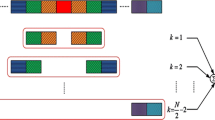Abstract
In performing short-distance, high-data-rate wireless communications using ultra-wideband (UWB) systems, it is necessary to reduce the average transmission power and ensure a fixed synchronization error between the transmitter and receiver ends. Furthermore, to reduce multipath interference, the UWB system should be sometimes implemented using a rake receiver. However, for such receivers, the delay time and attenuation loss over each transmitted route must be known in advance. In the present study, the complexity of rake receivers with a large number of “fingers” is reduced by means of a delay-hopped transmitted-reference (DHTR) scheme, in which the delayed signal is correlated with the original signal; thereby avoiding the need for a separate template signal. The synchronization performance of the proposed DHTR receiver is analyzed both theoretically and numerically. An effective timing synchronization scheme, designated as “parallel signal acquisition with shared looped delay-line” (PS-SLD), is then proposed. The simulation results show that for multipath environments with a single user, the proposed synchronization scheme achieves a higher detection probability and a lower normalized mean square error (MSE) than the traditional timing dirty templates (TDT) algorithm.








Similar content being viewed by others
References
Yang, L., & Giannakis, G. B. (2003). Low-complexity training for rapid timing acquisition in ultra-wideband communications. In Proceedings of IEEE global telecommunications conference (Vol. 2, pp. 769–773). San Francisco, CA.
Ho, M., Somayazulu, V., Foerster, J., & Roy, S. (2002). A differential detector for an ultra-wideband communications system. Proceedings of IEEE vehicular technology conference (Vol. 4, pp. 1896–1900).
Hoctor, R. T., & Tomlinson, H. W. (2002). An overview of delay-hopped transmitted-reference RF communications. Technique Information Series: G.E. Research and Development Center (pp. 1–29).
Hoctor, R., & Tomlinson, H. (2002). Delay-hopped transmitted-reference RF communications. In Proceeding of the IEEE Conference on Ultra Wideband Systems and Technologies (pp. 265–269).
Quek, T. Q. S., & Win, M. Z. (2005). Analysis of UWB transmitted-reference communication systems in dense multipath channels. IEEE Journal on Selected Areas in Communications, 23(9), 1863–1874.
D’Amico, A.A., Mengali, U., & Taponecco, L. (2007). Synchronization for differential transmitted reference UWB receivers. IEEE Trans. on wireless communications (Vol. 6, no. 11, pp. 5069–5073).
Liu, B., Lv, T., Qiao, Y., Liu, W, Gao, L. (2009). A novel synchronization algorithm in ultra-wideband system, In Proceedings of IEEE international conference onultra-wideband, ICUWB 2009 (pp. 556, 559).
D’Amico, A. A., & Taponecco, L. (2006). A differential receiver for UWB systems, IEEE trans. on wireless communications (Vol. 5, no.7, pp. 1601,1605).
Romme, J., & Witrisal, K. (2006). Transmitted-reference UWB systems using weighted autocorrelation receivers. IEEE Transactions on Microwave Theory and Techniques, 54(4), 1754–1761.
D’Amico, A. A. (2011). IR-UWB transmitted-reference systems with partial channel knowledge: A receiver design based on the statistical invariance principle, In IEEE trans. on signal processing (vol. 59, no. 4, pp. 1435, 1448).
Witrisaland, K., & Pausini, M. (2004). Equivalent system model of ISI in a frame-differential IR-UWB receiver. In Proceedings of IEEE global telecommunications conference, GLOBECOM ‘04 (Vol. 6, pp. 3505–3510).
Witrisal, K., Leus, G., Pausini, M., & Krall, C. (2005). Equivalent system model and equalization of differential impulse radio UWB systems. IEEE Journal on Selected Areas in Communications, 23(9), 1851–1862.
He, N., & Tepedelenlioglu, C. (2004). Adaptive synchronization for non-coherent UWB receivers. In Proceedings of international conference on acoustics, speech, and signal processing. (Vol. 4, pp. 517–520). Montreal, CA.
Djapic, R., Leus, G., & van der Veen, A.-J. (2004). Blind synchronization in asynchronous multiuser UWB networks based on the transmit-reference scheme. In Proceeding of asilomar conference on signals, systems, and computers. Pacific Grove, CA.
Carbonelli, C., Mengali, U., Franz, S., & Mitra, U. (2005). Semi-blind ML synchronization for UWB transmitted reference systems. In Proceedings of thirty-eighth Asilomar conference on signals, systems and computers (Vol. 1, pp. 100–105). Monterey, California, USA.
Yang, L., & Giannakis, G. B. (2005). Timing ultra-wideband signals with dirty templates. IEEE Transactions on Communications, 53(11), 1952–1963.
Chao, Y.-L., & Scholtz, R. A. (2004). Multiple access performance of ultra-wideband transmitted reference systems in multipath environments. In IEEE wireless communication and networking conference (Vol. 3, no. 5, pp. 1788–1793).
Mukhopadhyay, P. (2012). An introduction to the theory of probability (1st ed., pp. 270–272). Singapore: World Scientific.
Chen, P.-W. (2006). An Effective Synchronization Scheme for DHTR UWB Receiver. National Chi-Nan University, Master Thesis.
Decarli, N.Giorgetti, A., Dardari, D. & Chiani, M. (2011). Blind integration time determination for UWB transmitted reference receivers. In Prof. of global telecommunications conference (GLOBECOM 2011), 2011 IEEE, (pp. 1–5).
Shimizu, Y., & Sanada, Y. (2008). Analysis on/TR-UWB interference against narrowband systems. In Proceedings of IEEE international conference on ultra-wideband (Vol. 1, no. 8, pp. 75–78).
Author information
Authors and Affiliations
Corresponding author
Rights and permissions
About this article
Cite this article
Huang, TJ., Yang, JF. An Effective Timing Synchronization Scheme for DHTR UWB Receivers. Wireless Pers Commun 95, 3495–3508 (2017). https://doi.org/10.1007/s11277-017-4009-6
Published:
Issue Date:
DOI: https://doi.org/10.1007/s11277-017-4009-6




